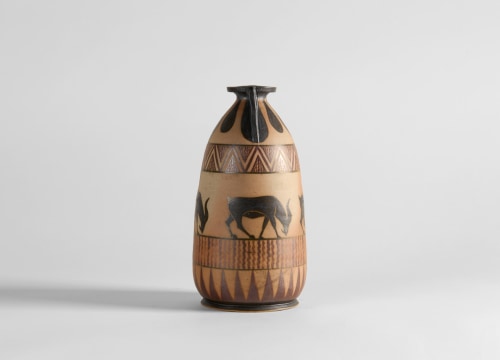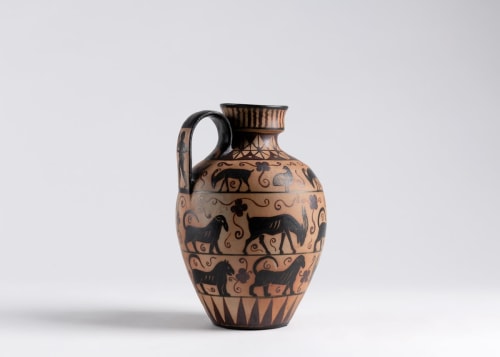

At the end of the World War I, the painter Louis Floutier (1882–1936), his brother-in-law, the cabinetmaker Étienne Vilotte (1881–1957), and the ceramist Marcel Lucat (1883–1953) founded a ceramics workshop in Ciboure, a town located in the Basque region of southwestern France. The Ciboure pottery would remain active until 1995.
In 1919 the firm specialized in the production of pieces with designs and shapes inspired by Ancient Greek terracotta (as these classical forms were the basis of any fine arts education at the time). All of the pieces were made of stoneware, largely composed of the region’s typical red clay, and fired at very high temperatures.
Floutier left in 1922, having decided to dedicate himself fully to painting, and Étienne Vilotte and his wife Elise took over the pottery, and began marking the pieces “VE Ciboure.” Their tenure lasted until 1945, during which time they introduced neo-Basque motifs, characteristic of local folklore: villagers, dancers, Basque pelota players (largely thanks their collaboration with local painters such as Almès, Le Coronne, and Garcia de Diego). Pieces from this epoch also often took utilitarian forms, typically Basque, such as the praktika (a sort of pitcher) and the gargoulette (a cooling jug).
At the end of the Second World War, the pottery, struggling financially, was sold to one of its retailers—Rodolphe Fischer, a manager of a home decoration shop, who had fallen in love with Ciboure’s creations during a holiday in the Basque country. Fischer owned the pottery until 1977. During this period, the production evolved again, this time incorporating new floral designs, such as apple blossoms and lotuses, arabesque patterns, and employing the Joralia glazing technique (all thanks, in this case, to Fischer’s creative wife, Suzanne). After 1977, Rudolphe’s son Max took the helm, and ran the business with his wife Carmen (daughter of noted decorator, and early Ciboure collaborator, Pedro Garcia de Diego) until their retirement in 1995.